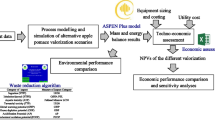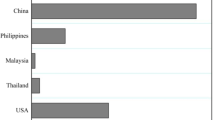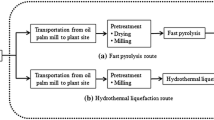Abstract
The fruit preservation industry in developing countries is growing rapidly and presents unique opportunities for promoting environmental sustainability. However, very few life cycle assessment studies have evaluated the environmental performances of current production technologies in developing countries. This study represents the first life cycle assessment to compare two common production lines of the preserved plum industry in Southern China and suggested strategies for improving their environmental performances. The first line, commonly adopted by medium-sized plants, included washing, osmotic treatment, blanching, superheated steam coupled with far-infrared radiation for drying, packaging and wastewater treatment stages. The second line, commonly utilized by small-sized plants, consisted of washing, osmotic treatment, drying by natural ventilation, packaging and wastewater treatment stages. The comparison suggested that the first production line resulted in higher fossil fuel depletion, ozone depletion, human health noncancer, respiratory and ecotoxicity impacts than the second production line. In contrast, the second production line resulted in higher photochemical formation, global warming, acidification, human health cancer and eutrophication impacts. Electricity and wastewater treatment, together, were the dominating contributors to most of the life cycle environmental impact categories. The sensitivity analyses suggested that the life cycle global warming impacts were most sensitive to electricity use, while the wastewater amount ranked as the most influential factor for the life cycle eutrophication impacts. In addition, the scenario analyses indicated that upgrading the activated sludge process to a membrane bioreactor process, for in-plant wastewater treatment, alone would increase life cycle fossil fuel depletion, photochemical formation, acidification and respiratory impacts. However, the combinational adoption of a membrane bioreactor process and electricity derived from wind or lignocellulosic biomass can significantly reduce life cycle environmental impacts of the plum preservation plants.
Graphic abstract






Similar content being viewed by others
References
Amit SK, Uddin MM, Rahman R, Islam SMR, Khan MS (2017) A review on mechanisms and commercial aspects of food preservation and processing Agriculture & Food. Security 6:51
Anna Lucia Mourad LC, Oliveira PAPLV, Kletecke RM, Baddini JPOA (2007) A simple methodology for elaborating the life cycle inventory of agricultural products. Int J Life Cycle Assess 12:408–413
Bare JC (2011) TRACI 2.0: the tool for the reduction and assessment of chemical and other environmental impacts 2.0. Clean Technol Environ Policy 13:687–696
Bare JC, Norris GA, Pennington DW, McKone T (2003) TRACI—the tool for the reduction and assessment of chemical and other environmental impacts. J Ind Ecol 6:49–78
Beccali M, Cellura M, Iudicello M, Mistretta M (2010) Life cycle assessment of Italian citrus-based products: sensitivity analysis and improvement scenarios. J Environ Manag 91:1415–1428
Brodt S, Kramer KJ, Kendall A, Feenstra G (2013) Comparing environmental impacts of regional and national-scale food supply chains: a case study of processed tomatoes. Food Policy 42:106–114
Camargo GGT, Ryan MR, Richard T (2013) Energy use and greenhouse gas emissions from crop production using the farm energy analysis. Bioscience 63:263–273
Cashman S, Ma X, Mosley J, Garland J, Crone B, Xiaobo X (2018) Energy and greenhouse gas life cycle assessment and cost analysis of aerobic and anaerobic membrane bioreactor systems: Influence of scale, population density, climate, and methane recovery. Bioresou Technol 254:56–66
Coley D, Howard M, Winter M (2009) Local food, food miles and carbon emissions: A comparison of farm shop and mass distribution approaches. Food Policy 34:150–155. https://doi.org/10.1016/j.foodpol.2008.11.001
Costello C, Griffin WM, Matthews HS, Weber CL (2011) Inventory development and input-output model of US land use: relating land in production to consumption. Environ Sci Technol 45:4937–4943
Curran MA (2013) Life cycle assessment: a review of the methodology and its application to sustainability. Curr Opin Chem Eng 2:273–277
De Marco Iolanda, Iannone R (2017) Production, packaging and preservation of semi-finished apricots: a comparative life cycle assessment study. J Food Eng 206:106–117
de Vries M, de Boer IJM (2010) Comparing environmental impacts for livestock products: a review of life cycle assessments. Livest Sci 128:1–11. https://doi.org/10.1016/j.livsci.2009.11.007
Del Borghi A, Gallo M, Strazza C, Del Borghi M (2014) An evaluation of environmental sustainability in the food industry through life cycle assessment: the case study of tomato products supply chain. J Clean Prod 78:121–130
Deng L, Zhang F, Wang H, Pan M, Liu J (2017) Development status and market prospect of instant food in China storge and process 17:112–121
Department of Ecology and Environment of GuangDong Province (2018) Industrial wastewater discharge standard in GuangDong Province. http://www.gdep.gov.cn/hbbz/df/
Energy Information Administration (2011) Country Analysis Briefs. http://www.eia.gov/cabs/china/Full.html
Green Delta The openLCA software (2018). http://www.openlca.org/openlca/new/
Hai J, Zhao M, Lin L, Dong Y (2015) isolation and identification of bioactive compounds with antioxidant activities from Sanhua Plum (Prunus salicina Lindl.). Mod Food Sci Technol 31:106–110
Heller MC, Keoleian GA, Willett WC (2013) Toward a life cycle-based, diet-level framework for food environmental impact and nutritional quality assessment: a critical review. Environ Sci Technol 47:12632–12647. https://doi.org/10.1021/es4025113
Howarth RW, Boyer EW, Pabich WJ, Galloway JN (2002) Nitrogen use in the United States from 1961 to 2000 and potential future trends. Ambio 31:88–96
Huijbregts MAJ et al (2016) ReCiPe2016: a harmonised life cycle impact assessment method at midpoint and endpoint level. Int J Life Cycle Assess 22:138–147
Humbert S, Rossi V, Margni M, Jolliet O, Loerincik Y (2009) Life cycle assessment of two baby food packaging alternatives: glass jars vs. plastic pots. Int J Life Cycle Assess 14:95–106
ISO 14040:2006 Environmental management—Life cycle assessment—Principles and framework. https://www.iso.org/standard/37456.html
Karakaya A, Özilgen M (2011) Energy utilization and carbon dioxide emission in the fresh, paste, whole-peeled, diced, and juiced tomato production processes. Energy 36:5101–5110
Khatri P, Jain S (2017) Environmental life cycle assessment of edible oils: a review of current knowledge and future research challenges. J Clean Prod 152:63–76
Lazarides H (2011) Food processing technology in a sustainable food supply chain. Procedia Food Sci 1:1918–1923
Li C, Jia W, Ye X, Yu Q (2012) Development and prospects of new energy in China electric power science and engineering:04
Liu Y (2015) China’s Guangdong Province Speeds Up Development of the Province’s Clean Energy Industry. https://www.renewableenergyworld.com/articles/2015/09/china-s-guangdong-province-speeds-up-development-of-the-province-s-clean-energy-industry.html
Lundie S (2005) Life cycle assessment of food waste management options. J Clean Prod 13:275–286
Pelletier N, Leip A (2013) Quantifying anthropogenic mobilization, flows (in product systems) and emissions of fixed nitrogen in process-based environmental life cycle assessment: rational, methods and application to a life cycle inventory. Int J Life Cycle Assess 19:116–123
Prosapio Valentina, Norton Ian, Marco ID (2017) Optimization of freeze-drying using a life cycle assessment approach: strawberries’ case study. J Clean Prod 16:1171–1179
Rotz CA, Montes F, Chianese DS (2010) The carbon footprint of dairy production systems through partial life cycle assessment. J Dairy Sci 93:1266–1282. https://doi.org/10.3168/jds.2009-2162
Roy P, Nei D, Orikasa T, Xu Q, Okadome H, Nakamura N, Shiina T (2009) A review of life cycle assessment (LCA) on some food products. J Food Eng 90:1–10. https://doi.org/10.1016/j.jfoodeng.2008.06.016
Sanjuán Neus, Stoessel Franziska, Hellweg S (2014) Closing data gaps for LCA of food products: estimating the energy demand of food processing. Environ Sci Technol 48:1132–1140
Silva VL, Sanjuán N (2019) Opening up the black box: a systematic literature review of life cycle assessment in alternative food processing technologies. J Food Eng 250:33–45
The ecoinvent Organisation (2019) The ecoinvent Database. https://www.ecoinvent.org/database/database.html
Tilman D, Clark M (2014) Global diets link environmental sustainability and human health. Nature 515:518–522. https://doi.org/10.1038/nature13959
Turconi R, Boldrin A, Astrup T (2013) Life cycle assessment (LCA) of electricity generation technologies: overview, comparability and limitations. Renew Sustain Energy Rev 28:555–565
US Energy Information Adminstration (2017) Chinese coal-fired electricity generation expected to flatten as mix shifts to renewables. https://www.eia.gov/todayinenergy/detail.php?id=33092
Vignali G, Manfredi M (2014) Life cycle assessment of a packaged tomato puree: a comparison of environmental impacts produced by different life cycle phases. J Clean Prod 73:275–284
Wang S, Zhou A, Yang X, Yang J, Huang K, Chen H (2017) Study on the heat pump technology of Shuanghua-Plum Preserved Science and Technology of Food Industry 38:227–232
Weber CL, Matthews HS (2008) Food-miles and the relative climate impacts of food choices in the United States. Environ Sci Technol 42:3508–3513
Xue X (2011) Evaluating eutrophication potential of bioproducts using life cycle assessment methods University of Pittsburgh
Xue X, Landis AE (2009) Effect of agricultural practices on biofuels’ environmental footprints. In: 2009 ISSST’09 IEEE international symposium on sustainable systems and technology pp 1–4
Xue X, Landis AE (2010) Eutrophication potential of food consumption patterns. Environ Sci Technol 44:6450–6456
Xue X, Landis AE (2014) Evaluating agricultural management practices to improve the environmental footprints of corn-derived bioproducts. Renew Energy 66:454–460
Xue X et al. (2018) Holistic analysis of urban water systems in the greater Cincinnati Region: (1) Life Cycle Assessment and Cost Implications Water Research Submitted
Xue X, Collinge WO, Shrake SO, Bilec MM, Landis AE (2012) Regional life cycle assessment of soybean derived biodiesel for transportation fleets. Energy Policy 48:295–303
Author information
Authors and Affiliations
Corresponding author
Additional information
Publisher's Note
Springer Nature remains neutral with regard to jurisdictional claims in published maps and institutional affiliations.
Electronic supplementary material
Below is the link to the electronic supplementary material.
Rights and permissions
About this article
Cite this article
Romeiko, X.X., Lin, S. & Huang, G. Life cycle assessment of preserved plum production in Southern China. Clean Techn Environ Policy 22, 197–209 (2020). https://doi.org/10.1007/s10098-019-01777-y
Received:
Accepted:
Published:
Issue Date:
DOI: https://doi.org/10.1007/s10098-019-01777-y




